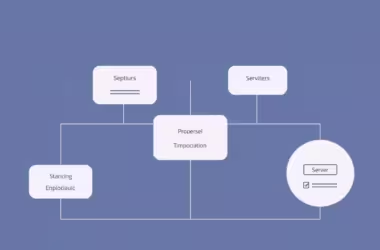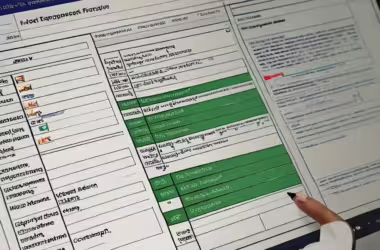Did you know serverless architecture is changing how we develop and deploy applications in the cloud? It offers scalable solutions and is cost-efficient. This is reshaping cloud computing, letting developers focus on creating new things.
This article will cover what serverless architecture is, its benefits, and how it’s used. We’ll also talk about the challenges and what the future looks like. Plus, we’ll share best practices for using serverless architecture. And we’ll introduce you to AppMaster.io, a platform that uses serverless technology for creating backend, web, and mobile apps.
Key Takeaways:
- Serverless architecture is changing cloud computing in a big way.
- It’s known for being affordable, scalable, and making things simpler.
- Serverless functions start when certain events happen. They are made to handle changes in need without storing data.
- This approach works great for web and mobile apps, processing data in real-time, and for automating tasks.
- To use serverless architecture well, you need the right provider, stateless functions, good performance, and strong security.
Understanding Serverless Architecture
Serverless architecture is based on an event-driven model. This model activates functions when specific events happen, like HTTP requests or changes in a database. These functions do not keep a persistent state and can grow to meet demand. With serverless, you pay for what you use, which ensures costs are kept low by only charging for the compute resources used during function execution.
Serverless lets developers focus on coding, not on managing servers. This event-driven approach means applications can react to real-time events fast. It leads to lighter, more manageable functions. So, development becomes faster, more adaptable, and highly scalable.
Being stateless, serverless functions can run at the same time, using resources well and cutting down on delays. This setup is perfect for workloads that change a lot, like unpredictable web traffic or tasks that need to be done now and then.
Serverless functions scale on their own, adjusting to workload changes smoothly. They can handle traffic spikes without losing performance or costing more. This flexibility makes serverless architecture stand out, especially for apps that face variable traffic.
The pay-per-use model of serverless computing links costs to resource use directly. Users pay only for the compute power they actually use, not for when servers are idle. This approach makes serverless an economical option for apps with changing or unpredictable traffic needs.
Below is a table summarizing the key characteristics of serverless architecture:
| Key Characteristics | Description |
|---|---|
| Event-driven model | Functions triggered by specific events |
| Stateless and scalable | No persistent state; automatically handle increased demand |
| Pay-per-use pricing | Users only pay for compute resources consumed |
This table and image give a clear picture of serverless architecture’s main ideas. Next, we’ll look at the advantages of using serverless, like lower costs, better scalability, easier operations, and faster development and roll out.
Benefits of Serverless Architecture
Serverless architecture gives businesses great benefits. Let’s look at some key advantages.
Cost Efficiency
Cost efficiency stands out as a big plus of serverless architecture. You pay only when your functions run. This way, costly upkeep when systems are idle is gone. This pricing model saves money for apps with varying work demands. It helps businesses use their budgets better by optimizing resources.
Scalability
Scalability is a major benefit of serverless architecture. It automatically adjusts to workloads, big or small. The cloud provider scales services as needed, no manual work required. This means businesses can grow quickly or handle busy times with ease.
Simplified Operations
Serverless architecture makes operations easier by shifting tasks to the cloud provider. No need to manage servers or update software. This change lets teams focus on coding and business goals. Cloud providers handle the rest, including monitoring and uptime. This saves time and resources for companies.
Rapid Development
Serverless functions are modular, making development and updates faster. Teams can work on different parts at the same time. This method speeds up work flow and gets new features out quicker. Serverless also offers ready-made templates and libraries, shortening development time.
High Availability
Serverless platforms ensure high availability by using multiple data centers. This setup keeps applications running smoothly, even if one location has issues. It enhances reliability and minimizes business disruptions.
Using serverless architecture brings many benefits. These include cost savings, easy scaling, simpler operations, quicker development, and reliable access.
Use Cases for Serverless Architecture
Serverless architecture supports many uses. It works well for different needs. Here are some important ways serverless architecture shines:
1. Web and Mobile Applications
Serverless architecture fits web and mobile apps with changing workloads well. It adjusts to traffic changes smoothly. This ensures apps work well without a hitch. It’s great for e-commerce sites and mobile apps. Developers can create strong, quick apps with serverless architecture.
2. Real-Time Data Processing
Serverless is top-notch for real-time data tasks. This includes stream processing and changing data. It deals with big data volumes fast due to its event-based setup. It’s ideal for analyzing IoT data or user content. With serverless, processing real-time data is manageable.
3. Backend for Frontend (BFF) Services
Serverless also works as a Backend for Frontend (BFF). It customizes backend logic for certain frontend apps. This lets developers enhance user experiences uniquely. It’s useful for updating mobile app data or web content dynamically. Serverless acts as an excellent BFF choice.
4. Automation and Scheduled Tasks
Serverless simplifies automating tasks on a schedule. It’s helpful for data backups and routine jobs. Serverless can handle ongoing maintenance with ease. It’s cost-effective and grows as needed. By taking over repetitive tasks, serverless boosts efficiency and saves resources.
| Use Case | Description |
|---|---|
| Web and Mobile Applications | Build responsive and scalable applications |
| Real-Time Data Processing | Handle large volumes of data in near-real-time |
| Backend for Frontend (BFF) Services | Deliver tailored backend logic for frontend applications |
| Automation and Scheduled Tasks | Automate recurring tasks and improve operational efficiency |
Serverless architecture suits many use cases. It helps developers use its advantages for different apps. Whether for creating apps, processing data, providing BFF services, or task automation, serverless is efficient and flexible.
Challenges and Considerations of Serverless Architecture
Serverless architecture has many advantages. But it also has challenges to think about. These include cold start latency, being tied to one vendor, and limited running time for functions.
Cold Start Latency
Cold start latency is about the delay when a function starts after a break. The cloud provider sets up a new instance, which takes time. So, there’s a wait before the function can handle the request.
This wait can slow down serverless apps. Cloud providers are trying to fix this. They’re using strategies like warming up instances ahead of time.
Vendor Lock-In
Vendor lock-in is a risk with serverless architecture. Organizations might depend too much on one cloud service. This can make switching providers hard later on.
Even though serverless aims to not depend on one vendor, each cloud service is different. Moving apps could mean changing and rewriting code. This uses more time and resources.
Limited Execution Time
Serverless functions have a time limit. This limit changes with each cloud provider. If a function runs too long, it gets stopped, which could lead to issues.
For tasks that need more time, other solutions might be needed. Breaking tasks into smaller functions or using other services can help overcome this limit.
It’s crucial to think about these challenges when choosing serverless architecture. Understanding the limits and looking for other options can help make the most of serverless, despite its challenges.
| Challenges | Description |
|---|---|
| Cold Start Latency | Delay in function execution due to the instantiation of new instances |
| Vendor Lock-In | Reliance on a specific cloud provider’s services, making it difficult to switch providers |
| Limited Execution Time | Functions constrained by a maximum execution time, requiring alternative solutions for long-running tasks |
The Future of Serverless Architecture
Serverless architecture is changing the future of cloud computing. It brings new chances for both developers and businesses. It makes the process of making and launching applications better and bigger scaled.
Reducing cold start latency is a main goal for serverless’s future. This latency is a small delay that happens when a serverless function first starts after being idle. The aim is to make these functions start faster, which will make them respond quicker and improve how users experience them.
More programming languages will soon be supported by serverless platforms. Right now, languages like JavaScript, Python, and Java are commonly used. But soon, developers could use their favorite programming languages to make serverless applications.
Enhanced tooling will also change serverless architecture. New tools and frameworks are coming. They’re being made to fix current problems and help developers work better. These tools will offer improved debugging, better monitoring and logging, and easier ways to put things out there.
The future looks good for serverless architecture. As cloud computing gets better, serverless will be key in pushing new innovations. It’s heading towards a future where cloud solutions are more effective and can scale better, thanks to faster startups, more languages, and better tools.
Serverless Architecture Use Cases
Serverless architecture is great for many situations. It offers good solutions for several important tasks. Here are the main areas where it does a great job:
Data Processing
Serverless architecture is a big help in managing lots of data. It processes data fast and can scale up as needed. This makes it perfect for applications that deal with lots of data and need results quickly.
Web Application Development
Creating web applications is easier with serverless architecture. It takes care of deployment and scaling, so developers can focus on coding. This means faster development and quicker delivery times.
API Development
Building APIs is more efficient with serverless functions. They use resources wisely and manage changing levels of requests well. Serverless makes APIs that can scale and stay reliable, even under unpredictable loads.
Mobile Backend Services
For mobile backends, serverless is a perfect fit. It adjusts easily to changing demands from mobile apps. Serverless functions scale dynamically, keeping mobile services running smoothly no matter the workload.
Scheduled Tasks and Automation
Serverless makes it simple to automate repetitive tasks. It runs scheduled jobs without needing servers. Whether for data backups, running periodic jobs, or other tasks, serverless is an efficient, money-saving option.
These examples show how flexible and powerful serverless architecture can be. It’s great for data processing, web and mobile app development, API creation, and automation. Serverless offers scalable, efficient, and cost-effective solutions for these needs.
| Use Case | Benefits |
|---|---|
| Data Processing | Efficient and near-real-time handling of large volumes of data |
| Web Application Development | Streamlined deployment and scaling processes, faster development cycles |
| API Development | Efficient resource utilization, handling fluctuations in request volume |
| Mobile Backend Services | Accommodates fluctuating user demand, dynamic scaling for scalability |
| Scheduled Tasks and Automation | Efficient execution of recurring tasks, cost-effective solution |
AppMaster.io: Embracing Serverless Architecture
AppMaster.io is a no-code platform that helps developers use serverless architecture for various applications. It simplifies building applications by letting users visually create data models and design business logic. Users can also develop customizable user interfaces with ease.
AppMaster.io’s serverless architecture improves application scalability. It handles increasing workloads well without losing performance. Developers don’t need to manage servers, so they can focus on creating new features instead.
This platform ensures steady performance through serverless computing. It allocates resources as needed, making applications reliable and stable. This leads to better user experiences and higher customer satisfaction.
Maintenance is easier with AppMaster.io too. Developers don’t have to stress over updates or scaling. The platform takes care of these tasks, giving developers more time to add value to their applications.
AppMaster.io also offers scalability for any business size. No matter if it’s a small project or a big enterprise application, the platform can adjust to any business’s needs.
AppMaster.io makes it simple for developers to create top-quality applications quickly. Its easy-to-use interface, wide range of features, and powerful serverless infrastructure are perfect for speeding up application development. This platform ensures excellent user experiences across both web and mobile platforms.
Best Practices for Implementing Serverless Architecture
Getting serverless architecture right means considering several key practices. These ensure top performance, scalability, and security. By following these guidelines, developers can tap into the full power of serverless tech.
Choosing the Right FaaS Provider
Choosing the right Function as a Service (FaaS) provider is key. You should look at supported languages, how well it integrates with other services, its performance, and how it’s priced. Some top options include AWS Lambda, Azure Functions, and Google Cloud Functions.
Ensuring Stateless Functions
Stateless functions are core to serverless architecture. They must be designed without dependency on a persistent state. This approach boosts scalability, eases management, and simplifies testing and deployment. Make sure each function stands alone and avoids global variables or shared resources.
Optimizing Performance
For serverless applications to run smoothly, performance must be optimized. This means keeping an eye on your functions to reduce delays and use resources best. Look at things like how many functions run at once, network delays, and the time it takes for cold starts. Using tools to check on function performance can help find and fix any slowdowns.
Ensuring Adequate Security
Serverless changes how we think about security. Strong authentication and access controls are needed to guard your functions. Stick to top security practices for protecting data when it’s being sent or stored. Keep your dependencies up-to-date and fix security gaps fast. Running security checks and tests often is crucial for spotting and fixing risks.
| Best Practice | Description |
|---|---|
| Choose the Right FaaS Provider | Research and select a FaaS provider that meets your specific needs, considering factors such as supported languages, integrations, and performance. |
| Ensure Stateless Functions | Design functions that are self-contained and do not rely on persistent state or shared resources for scalability and ease of management. |
| Optimize Performance | Monitor and fine-tune functions to minimize latency, improve resource utilization, and optimize cold start times. |
| Ensure Adequate Security | Implement robust security measures, including authentication, authorization, encryption, and regular security audits. |

Conclusion
Serverless architecture is changing how developers make apps. It removes the hassle of managing infrastructure. This lets developers focus on code and new features.
It offers many benefits like saving costs, scaling easily, simplifying operations, quick development, and being always available. These advantages make it great for companies wanting to improve their cloud services.
However, there are challenges like cold start delays and being tied to one vendor. But, the outlook for serverless is positive. As technology gets better, we’ll see faster functions and support for more programming languages.
Tools for serverless will also get better. This will help developers make and deploy apps more easily. By using serverless, companies can be more innovative and agile.
The flexible and scalable nature of serverless lets them launch apps fast. It can adapt to different loads and use resources wisely. Serverless is shaping the future of cloud computing. It enables developers to create groundbreaking apps.






